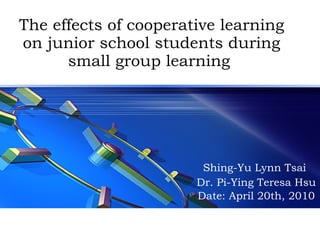
First presentation
- 1. The effects of cooperative learning on junior school students during small group learning Shing-Yu Lynn Tsai Dr. Pi-Ying Teresa Hsu Date: April 20th, 2010
- 3. Contents Reflections Results Methodology Introduction
- 4. Introduction A B C Assistance with the task Sharing resources Encouraging each other’s efforts ( Johnson & Johnson, 1999 ) Cooperative Learning:
- 7. Introduction Purpose: : to investigate students’ perceptions of what happens during their cooperative learning experiences
- 8. Research Questions Q1: What are the effects of structured and unstructured cooperative learning experiences on students’ behaviors , interaction , and learning ? Q2: Do students’ perceptions of what happens during cooperative learning differ for students in structured and unstructured groups?
- 9. Methodology Participants Procedure of the Study Experimental Design Instruments Data Analysis
- 10. Participants 223 students 2000.10 Add Your Text 14 years ( grade 9 ) 2001.10 Add Your Text Australia 99 students ( structured ) 124 students ( unstructured ) 2001.10 Add Your Text 6 schools: 3 ( structured ) 3 ( unstructured ) Mathematics 2001.10 Add Your Text School Group Class Age Place Number
- 11. Procedure Before During During After Structured group: task interdependence vs. Unstructured Group: No task interdependence Group observation by video taped Placement test Mathematics& what happened in the groups questionnaire
- 12. Grouping Grouping 1 low achiever (bottom 25%) 1 intermediate achiever (middle 25%) 1 intermediate achiever (middle 25%) 1 high achiever (top 25%) Placement test
- 14. Group-problem solving Draw on the information Prove questions Analyze, synthesize, critique situations
- 15. Instruments Mathematics questionnaire Group observation What happened in the groups questionnaire
- 16. Group observation Protocol: Behavior ( Sharan& Shachar, 1988; Gillies& States, 1996 ) B C D Cooperative behavior A Noncooperation behavior Individual task-oriented behavior Individual non-task behavior
- 17. Group observation Protocol: Interaction Directives with physical prompt (hand gestures) Unsolicited explanation (no request to cooperative) Unsolicited terminal (no request to give short response) Positive interruption (interjects to help) Negative interruption (yells out) Solicited explanation (request for assistance) Unsolicited terminal (request to give short response) Nonspecific interaction (Webb, 1985; Gillies& Ashman, 1998) Directives (verbal instruction) A B 3 C 4 D E F G 3 H 4 I
- 18. Mathematics questionnaire Bloom (1956) Two mathematics teacher What are square numbers? What is the tenth square number in the sequence? Mathematics questionnaire
- 19. WHGQ questionnaire 1 2 3 4 5 strongly disagree strongly agree Johnson& Johnson, 1990; Gillies& Ashman, 1996 15 items Crobach’s alpha: 0.78
- 20. WHGQ questionnaire Positive interdependence Interpersonal communication Facilitation of each other’s efforts WHGQ items Individual responsibility Group processing Motivation Attitudes Behaviors
- 21. Data Analysis ANCOVA Learning (Q1) MANCOVA Behavior& Interaction (Q1) MANCOVA Perceptions to WHGQ (Q2)
- 22. Results The children in the unstructured groups displayed more noncooperation and more individual non-task behaviors than their peers in the structured groups.
- 23. Results The children in the unstructured groups gave more unsolicited terminal, positive interruption and negative interruption response than the children in the structured groups. The children in the structured groups gave more unsolicited explanations and solicited explanations than their peers in the unstructured groups.
- 24. Results Table 3 Means and standard deviation of mathematic learning outcome in the structured and unstructured groups The children in the structured groups attained a higher learning outcome score than their peers in the unstructured groups. P< 0.001 Mean SD F Structured 2.07 0.57 15.91 Unstructured 1.63 0.73
- 25. Results Table 3 Means and standard deviation of students’ perceptions of what happened in the structured and unstructured groups The children in the unstructured groups reported group members were less likely to interrupt or cut each other off. They were more likely to listen to each other , ask to each other to elaborate on their points , share their ideas , and help each other than the children in the unstructured groups.
- 26. Reflections ? Lack of sample items of mathematics questionnaire ? Reliability of the placement test ? Reliability of the mathematics questionnaire ? Lack of sample items of WHGQ questionnaire
- 27. Reflections ? What the class activity in the unstructured groups ? The criteria of the grouping ? ? How did the participants know those five elements of CL How many classes participated in the study